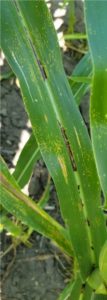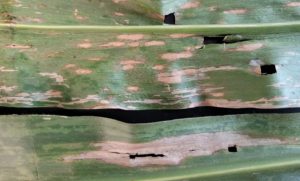In October, I visited a field of corn in Jackson County. Plants had dark brown, circular spots on stalks and the midribs of leaves (Figure 1). Associated with the dark spots on the midrib were smaller spots on the leaf blade that looked like southern rust. There also was a repeating pattern associated with these spots. The disease was Physoderma brown spot, caused by the fungus Physoderma maydis. I confirmed it by examining spores from spots under the microscope. Previously, the only time I’ve seen this disease was when I visited colleagues in Iowa on a trip to look at diseases that don’t occur in Texas.
Physoderma brown spot is not a new disease in Texas. More than a century ago, it was reported to be present in the eastern third of the state, including Upper Gulf Coast counties. A 1952 Texas Agricultural Experiment Station bulletin mentioned that it was a minor disease and its progression on a plant, including stalk breakage, was stopped by the normal hot weather of the growing season. I think this is why the disease is absent or unnoticed during the normal growing season and is not likely to be a future threat to corn production in Texas. Modern hybrids may also have more resistance to the fungus.
The disease is well understood. The pathogen has motile spores, making free water critical for the disease to progress. Infection starts in the leaf whorl, several weeks after germination. A fungal requirement for light explains the alternating bands of infection.
In Iowa, I observed differences in susceptibility of corn hybrids. In other fields in Jackson county, with different hybrids, I did not see this disease. The disease is also managed by burying crop debris and crop rotation.
Figure 1. Symptoms of Physoderma brown spot on a corn stalk and leaf, from Jackson county, Oct., 2022.
Another foliar fungal disease that is not common in Texas is southern corn leaf blight (SCLB), caused by the fungus, Cochliobolus heterostrophus. In most of Texas, the more common foliar fungal pathogen is northern corn leaf blight, caused by Setosphaeria turcica. I have seen SCLB on a recurring basis only on fall corn in the Lower Rio Grande Valley. Leaf lesions of SCLB are smaller, with relatively blunt ends, while those of NCLB are larger and have tapered ends (Figure 2). If there is a question about which fungus is causing a lesion, the diagnosis can be confirmed with a microscopic examination of the spores in those lesions. Although both diseases are controlled with most of the foliar fungicides labeled on corn, the usual (dry) Texas climate seems to do an effective job at minimizing yield-limiting damage. I consider both SCLB and NCLB to be minor diseases of corn in Texas, in contrast with southern rust. There are hybrid differences in susceptibility to SCLB: for example, in a Hidalgo County field, one hybrid had extensive SCLB and the other, adjacent hybrid did not. Crop rotation and residue burial will reduce the future potential for infection.
Figure 2. Leaf symptoms of southern corn leaf blight (top), contrasted with northern corn leaf blight (bottom). Leaves were from the same field in Hidalgo County, October 2022.
Thomas Isakeit, Professor and extension plant pathologist
Texas A&M AgriLife Extension Service, College Station
thomas.isakeit@ag.tamu.edu; cell 979-229-4976


